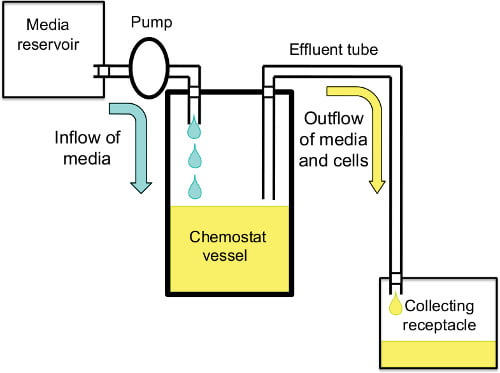Microbial Culture can be cultivated in either Batch or Continuous method.
Microorganisms are omnipresent. But when we intend to study or use them, we grow and multiply the desired microbial species in artificial environment or laboratory conditions. The microbes grown in laboratory are called as microbial culture. To grow microorganisms, we need to provide them sufficient nutrients and physical conditions. Based on the limited or unlimited supply of nutrients, the microbial culture are classified as Batch and Continuous culture.
Batch Microbial Culture-
- It is a closed system.
- In Batch culture, once the nutrients are provided they are not replenished.
- There is no scope or facility for removing the waste material.
- Once the nutrients are exhausted and when toxic materials are accumulated it causes death of microorganisms.
- Microbial culture grown in batch culture shows typical bacterial growth curve with four different phases.
- Before the bacterial culture die in the batch culture, the bacteria needs to be subculture.
- The best and simple example for batch culture is the conical flask or Batch fermenter.
- It is mostly used for studying bacterial growth curve and or antibiotic production.


Continuous Microbial Culture –
- It is a open system
- In continuous culture, there is continuous supply of nutrients.
- There is facility of continuous removal of waste material.
- It is one of the ideal system to grow the bacteria in log phase.
- The nutrient supply determines the growth rate of microorganisms.
- As the nutrients are not exhausted and there is no accumulation of waste and hence, the microorganisms can grow continuously.
- The well known system for continuous culture is Turbidostat and chemostat.
- They are used for metabolite, proteins, vaccine or acid production.
Continuous culture methods –
The microbes can be grown in batch or continuous culture. In batch culture, limited nutrients are provided to microbes whereas in continuous culture, the supply of nutrients and removal of toxins is continuous. In batch culture, we have seen that bacteria shows four phases namely lag, log, stationary and death phase. The stationary and death phase are caused by exhaustion of nutrients and accumulation of toxins. The continuous culture overcome this problem and can maintain the culture in log phase. There are two major type of continuous culture Chemostat and Turbidostat
THE CHEMOSTAT –
A chemostat (means chemical environment is static) is a bioreactor to where fresh medium is continuously added and the waste and toxic material is removed. The rate of nutrients added is equal to rate of removal of waste and hence the total content and volume of the material inside chemostat remains constant..
Mostly, the rate limiting nutrients are amino acids. The growth of the microorganism is controlled and regulated by the concentration of such rate limiting nutrients. The rate of nutrient exchange is expressed as the dilution rate (D), the rate at which medium flows through the culture vessel relative to the vessel volume, where f is the flow rate (ml/hr) and V is the vessel volume (ml).
D = f/v
There is no change in the microbial population density as both the microbial population and generation time is related to the dilution rate.
- When there is increase in the dilution rate the generation time decreases.
- Under balance condition the limiting nutrients will be continuous utilized by the microbes (rate of inflow of nutrients and rate of utilization is equal).
- If the dilution rate increases the microorganism can actually be washed out of the culture vessel before reproducing as the inward flow of nutrient is much faster and this will lead to wash out of microorganism.

THE TURBIDOSTAT
This is second type of continuous culture, where the growth is regulated by monitoring turbidity of the culture. As it is continuous culture, the inflow rate of nutrients is equal to rate of removal of waste. When microbes are inoculated in the fresh and sterile media, the media is almost transparent. As the microbe star multiplying, the increase in microbe number causes increase in the turbidity and this turbidity continuously measured by instrument photocell which works on the principle of Beer-Lamberts law. The photometer through incident light on the vessel on turbidostat, this is light is absorbed by the microbes. The transmitted light is measured by photometer. The absorption of light is directly proportional to concentration or number of cell.

When turbidity reaches up to required level, this message is sent to the pump which maintains the inflow of nutrient media. The motive is to maintain constant turbidity.
The continuous cultures are used in Bioindustries to maintain the bacteria in required state or phase of bacterial growth curve. Such cultures are also used for research purpose to study the nutritional needs, physical environment and physiological studies of microbes.
Comparison of Chemostat and Turbidostat
| Chemostat | Turbidostat | |
| Definition | The continuous system in which is growth of microbe is maintained by limited concentration of particular nutrient | The continuous system in which growth of microbe is maintained and monitored by turbidity. |
| Dilution rate | Dilution rate remains constant | Dilution rate varies |
| Inflow of media | Fresh medium is continuously added and at the same rate waste is removed. | The inflow of fresh medium is maintained by the signal received from photometer |
| Factor that is constant | Chemical composition of nutrient media is constant | Turbidity of nutrient media is constant |
References –
- Willey, J. M., Sherwood, L., Woolverton, C. J., Prescott, L. M., & Willey, J. M. (2011). Prescott’s microbiology. New York: McGraw-Hill.
- http://www.davidmoore.org.uk/21st_Century_Guidebook_to_Fungi_PLATINUM/Ch17_11.htm
- http://cribme.com/uta/data/Biology/General%20Microbiology%203444/Notes/lecture9.pdf
- https://www.sciencedirect.com/topics/earth-and-planetary-sciences/chemostat


